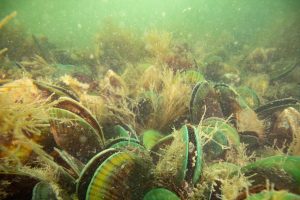
Toitū te Waitematā – Ōkahu Bay Restoration Project
Ngāti Whātua Ōrakei, scientists and conservationists are deploying a secret underwater weapon in the fight to save the struggling Waitematā – Mussels.
Today the latest batch of 60 Tonnes of kūtai / green-lipped mussels are being dropped into the waters of Ōkahu Bay next to downtown Tāmaki Makaurau / Auckland.
“For the hapū this is part of multigenerational project to improve the mauri / life essence, and restore the health of our whenua rangatira and our moana, the Waitematā, says Rangimarie Hunia, Ngāti Whātua Ōrakei Whai Māia CEO.
“As kaitiaki, we want to bring back healthy abundance to what was once our pātaka kai,” she says. “Our hope is that one day our mokopuna, and their tamariki, are able to gather shellfish like their great great grandparents did.”
The project is part of a wider ambitious plan to recreate the kūtai reefs which used to carpet the Hauraki Gulf. They were dredged into functional extinction last century.
The aim is to use mussels to build back biodiversity including tāmure/snapper and other taonga species.
“This project is a three year living experiment that will help us understand how to build mussel reefs at scale, says Peter Miles from the Mussel Reef Restoration Trust, part of the Revive our Gulf project.
“It’s a highly collaborative working model, we hope it will inspire other mana moana groups across the Hauraki Gulf to jump aboard this kaupapa.”
Kūtai are restoration superheroes – scientists call them ‘ecosystem engineers’ for their ability to filter water, provide shelter and sustenance for an entire community of undersea creatures.
Peter Van Kampen from international environmental NGO, the Nature Conservancy, also part of the Revive Our Gulf project, says they’re trialling two different key conditions in Ōkahu Bay to test how well kūtai survive on the soft sediment seafloor vs a substrate of shell.
“The University of Auckland Institute of Marine Science and Ngāti Whātua Ōrākei will be monitoring closely over the coming months and years to see how the two sets of beds perform.”
Ultimately, van Kampen says this is all about understanding what is needed to restore at scale.
“When we started this project many years ago we spoke of a day when the bay would smell different, taste different, look different and feel different,” says Moana Tamaariki-Pohe MNZM, Ngāti Whātua Ōrakei.
“This is another step closer to that day. It feels good to think that my son will one day experience an Ōkahu Bay of abundance like his tupuna once did.”
| When and Where |
Tuesday 30 November at 11.30am at the Landing, Akarana Yacht Club on Tāmaki Drive.